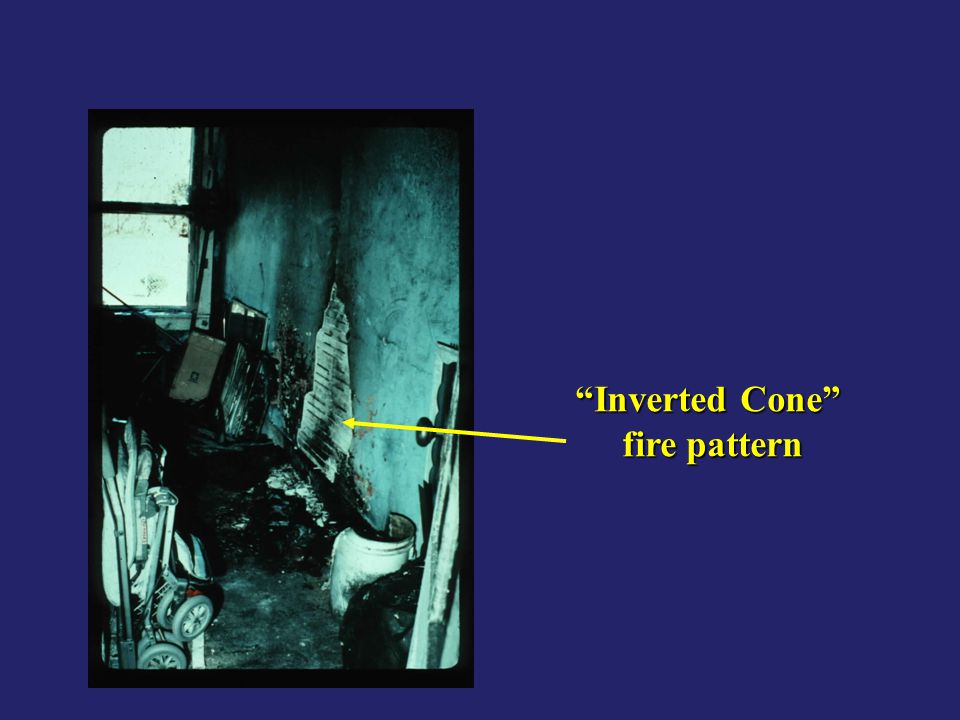Fire and Arson Investigations. Fire Patterns The visible or measurable physical changes or identifiable shapes formed by a fire effect or group or fire effects.

Triangle Shaped Pattern Also Called An Inverted Cone Pattern Produced Download Scientific Diagram
Tap card to see definition.

. This pattern includes heavily burned material surrounded by less burned material. Select the correct answer for each of the following questions. It is a pattern that forms when an accelerant is used to ignite a fire.
Click card to see definition. The inverted cone or triangular pattern resembles an upright triangle with the vertex at the top. Various types of fire patterns such as.
Combustible surface 1 3 6 2 5 3 4 3 7. Often a saddle burn is caused by a burning liquid on the floor or radiant heat from a material close to the floor. Package is located away from the witness surface the resulting fire pattern is shaped as a U evident by its radial or curved lines of demarcation Figure 3.
Click again to see term. Accident or accelerant pourd. A burnt pattern of inverted cone indicates a.
Copyright 2012 from Scientific Protocols for Fire Investigation 2nd Edition by John J. For example according to NFPA 921-2017 the burning of leaking natural gas tends to produce inverted cone patterns so a manifestation of a small inverted cone pattern could likely be representative of. This triangular pattern is characteris- A hot gas layer develops at the ceiling and gradually this tic of young fires.
A fire pattern is defined in NFPA 921 as the visible or measurable physical change or identifiable shapes formed by a fire effect or group of fire effects 3. Tap again to see term. Mark only one answer for each item by marking the box corresponding to the letter of your choice on the answer sheet provided.
Calcination SURFACE EFFECTS 3. Various types of fire patterns such as. Triangle-shaped pattern also called an inverted cone pattern produced in a test fire.
Illustration of the Fire Plume and Truncated Cone Pattern Development LITERATURE REVIEW Several studies have been conducted to help identify the fire patterns in compartment. Previous fire pattern research by the National Institute of Justice NIJ the National Institute of. Flammable liquid burn pattern PENETRATIONS 6.
This pattern is always due to the use of an accelerant that more severely burned that which it came into contact with. Inverted cone patterns interpreted as conclusive evidence of flammable liquid fires. Tap again to see term.
If this cone intersected or truncated by a wall the fire will produce a triangle pattern. Identifying the Point of Origin. Wider along the floor and narrower as it burns upwards.
The various marks and patterns permanently imprinted on the structure and contents by the smoke heat and fire point the observant fire investigator in the direction of area of fire origin. As a result the observations are typically qualitative in nature. Phase whereby the fire can no longer support the flame and carbon monoxide builds up in volume.
Investigators reconstructing fire scenes 7. Free burning phase d. The inverted cone or triangular pattern resembles an upright triangle with the vertex at the top.
The first pattern under consideration is an inverted cone or triangular pattern. Click again to see term. During this fire phase the burnt inverted cone pattern or fingerprint of fire is developed.
This flame zone pattern is associated with a fuel package that has the potential heat release rate to overcome the. Free burning phase d. At the scene of a vehicle fire through an alleged electrical fault when no remains of a battery can be located on board.
Fire patterns reproducibility and persistence This experiment demonstrated that nine of the burn patterns can be created during the burn test in the container house. Figure 1 is a schematic representation of how layer becomes thicker and more energetic. The burn patterns reproduced during the combustion experiments include V pattern U-shaped pattern Inverted cone pattern heat.
Narrow at bottom and rises going outward. A flammable liquid was used to start the fire An accelerant may have been used if the fire ____________ when water was applied. A U-shaped burn pattern found on the top of floor joists caused by fire burning down through the floor.
V-shaped hour-glass and inverted cone have come from common observation at actual fire scenes. Triangular patterns may referred to as inverted cone patterns this as a results of incompletely developed fires but not necessarily a separate point of origin. STRICTLY NO ERASURES ALLOWED.
Fire Technology and Arson Investigation I. Damage to ceiling LOSS OF MATERIAL 7. An inverted cone pattern on a wall indicates that.
This is not a pattern that occurs in nature. Inverted cone patterns Hourglass patterns U-shaped patterns Circular-shaped patterns. An inverted cone pattern.
Fire Pattern Examples FIRE PATTERN ANALYSIS DEMARCATIONS 1. Being able to identify plume-generated patterns is an important skill for a fire debris investigator because it allows for the identification of certain kinds of fires. Fire investigation texts describe the characteristics of the lines of demarcation associated with a plume-generated pattern as a progression through triangular columnar and conical patterns.
Any burning fuel source where the fire plume is not vertically restricted will produce inverted cone patterns.

Triangle Shaped Pattern Also Called An Inverted Cone Pattern Produced Download Scientific Diagram

Triangle Shaped Pattern Also Called An Inverted Cone Pattern Produced Download Scientific Diagram

Triangle Shaped Pattern Also Called An Inverted Cone Pattern Produced Download Scientific Diagram

Fire Patterns Associated With Ignitable Liquid Accelerants Ppt Video Online Download

Triangle Shaped Pattern Also Called An Inverted Cone Pattern Produced Download Scientific Diagram

Interfire A Site Dedicated To Improving Fire Investigation Worldwide
0 comments
Post a Comment